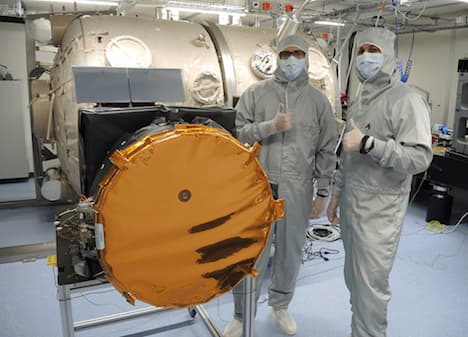Bernese telescope starts journey into space with cargo of children’s artworks

A space telescope constructed by engineers at the University of Bern has left Switzerland for Madrid ahead of its launch to explore other planets in 2019.
The CHEOPS telescope will take part in a mission to observe how planets in other solar systems pass in front of their host star – and help in the search for potentially habitable planets, the University of Bern reported.
The construction of the #space telescope #CHEOPS is finished and the instrument leaves the #unibern on April 10 to be integrated on the satellite platform in Madrid: https://t.co/48lzdvrIkQ @esa @AirbusSpace @CHEOPS_IT @NCCRPlanetS pic.twitter.com/jtamBZoweD
— Universität Bern (@unibern) April 5, 2018
Loaded safely in its transport container, the precious cargo left Bern on Tuesday bound for Madrid where it will be integrated into the satellite platform that supports it and enables it to operate in space.
The telescope was accompanied by 2,700 drawings drawn by children from Switzerland and across Europe, SRF TV reported.
These were miniaturized and lasered onto titanium plates which will be attached to the satellite.
Dank dem Cheops-Teleskop: Die @unibern schickt Kinderzeichnungen in das Weltall. https://t.co/k4rdKckszw pic.twitter.com/WM6QHdkqm2
— SRF Regionaljournal (@srfbern) April 7, 2018
CHEOPS will observe and measure the brightness of stars in our cosmic neighbourhood that are known to be orbited by exoplanets.
Stars’ brightness decreases slightly when an exoplanet passes in front of its host star allowing scientists to calculate the size of the planet.
"The instrument must be able to measure with extreme precision. This was the major design challenge," said Willy Benz of the CHEOPS mission, which Switzerland is carrying out together with the European Space Agency (ESA).
The telescope structure was designed and manufactured in Switzerland and the various parts were assembled there.
The optics as well as the flight software and other components originate from partner institutions in 11 other countries.
Before its departure for Spain the telescope was subjected to vibrations similar to those it will have to withstand at the start of its mission.
Switzerland paid around 30 million euros towards the telescope’s construction with a further 20 million coming from partners.
After the telescope is integrated into the satellite platform in Madrid, the satellite will be tested at several locations in Europe before being sent to ESA's space station in French Guiana.
It will return one last time to Switzerland in order to pass another vibration test before finally heading into space in 2019.
Comments
See Also
The CHEOPS telescope will take part in a mission to observe how planets in other solar systems pass in front of their host star – and help in the search for potentially habitable planets, the University of Bern reported.
The construction of the #space telescope #CHEOPS is finished and the instrument leaves the #unibern on April 10 to be integrated on the satellite platform in Madrid: https://t.co/48lzdvrIkQ @esa @AirbusSpace @CHEOPS_IT @NCCRPlanetS pic.twitter.com/jtamBZoweD
— Universität Bern (@unibern) April 5, 2018
Loaded safely in its transport container, the precious cargo left Bern on Tuesday bound for Madrid where it will be integrated into the satellite platform that supports it and enables it to operate in space.
The telescope was accompanied by 2,700 drawings drawn by children from Switzerland and across Europe, SRF TV reported.
These were miniaturized and lasered onto titanium plates which will be attached to the satellite.
Dank dem Cheops-Teleskop: Die @unibern schickt Kinderzeichnungen in das Weltall. https://t.co/k4rdKckszw pic.twitter.com/WM6QHdkqm2
— SRF Regionaljournal (@srfbern) April 7, 2018
CHEOPS will observe and measure the brightness of stars in our cosmic neighbourhood that are known to be orbited by exoplanets.
Stars’ brightness decreases slightly when an exoplanet passes in front of its host star allowing scientists to calculate the size of the planet.
"The instrument must be able to measure with extreme precision. This was the major design challenge," said Willy Benz of the CHEOPS mission, which Switzerland is carrying out together with the European Space Agency (ESA).
The telescope structure was designed and manufactured in Switzerland and the various parts were assembled there.
The optics as well as the flight software and other components originate from partner institutions in 11 other countries.
Before its departure for Spain the telescope was subjected to vibrations similar to those it will have to withstand at the start of its mission.
Switzerland paid around 30 million euros towards the telescope’s construction with a further 20 million coming from partners.
After the telescope is integrated into the satellite platform in Madrid, the satellite will be tested at several locations in Europe before being sent to ESA's space station in French Guiana.
It will return one last time to Switzerland in order to pass another vibration test before finally heading into space in 2019.
Join the conversation in our comments section below. Share your own views and experience and if you have a question or suggestion for our journalists then email us at [email protected].
Please keep comments civil, constructive and on topic – and make sure to read our terms of use before getting involved.
Please log in here to leave a comment.